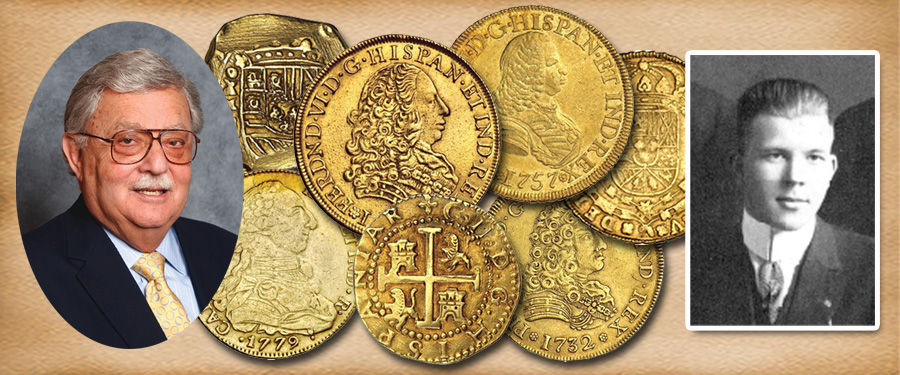
On our visit to Eagle’s Nest to deliver the gold
coins we had assembled for Mr. Lilly and that he had
examined during his visit to Stack’s in spring 1954, my father and I were able
to examine more closely the growing collection of lead soldiers, his nautical art
collection and a small section of his magnificent library.
The museum atmosphere at Eagle’s Nest was a treat
in itself. J.K. Lilly’s collection was arranged in
several rooms and provided a rare experience. He told us stories about
his “adventures”
in collecting and how he tried to preserve items for future viewing and study.
When we returned to New York, we contacted Clifford
T. Weihman who owned collections of $5 and $10 coins extracted from the
holdings of E.H.R. Green. We inquired if he was
interested in selling his collections to J.K. Lilly who was building a world-class gold
coin collection that would be greatly enhanced by this addition. Cliff Weihman
asked us how the Farouk Sale had gone and did we have any prices to guide him if he
were to sell. We explained to Weihman, that because of the restrictions
placed by the Egyptian Government, participation was geared toward dealers and
thus the Farouk sale reflected dealer values more than collector values.
Cliff Weihman understood. He told us he would
consider selling, if there could be a normal profit added to the prices the
Farouk Collection pieces had achieved at auction. He admitted to my
father and uncle that after he sold his foreign gold collection with Stack’s in
1951, he had moved on to collect not coins, but wines. He was so active in the Grand Chevalier Society, (the
foremost fine wine collectors in the world) that he was willing to consider making
the sale to Lilly, if he could get a fair price. We reviewed all the records,
compared the quality of the coins in each collection
(Farouk vs. Weihman) and suggested a price that Weihman agreed sounded fair.
At Stack’s we spent days preparing a comparison
list for Mr. Lilly and sent it to him for consideration. After a
few days we got a call from Mr. Lilly that he would be passing through New York in the
fall of 1954 on his way to Florida, and would like to see the Weihman coins.
We arranged with Cliff Weihman to keep his
collections in our vaults, so they would be ready for examination by
Lilly in the fall. We took full page pictures of the collections of $5 and $10
gold, bound a few sets of actual photographs and had all this ready for show
Mr. Lilly’s
on his fall visit. In more recent years these pictures have been used by gold coin
specialists to study varieties.
When Mr. Lilly arrived in New York in the fall of
1954 we showed him the Weihman/Col. Green coins. He was amazed
at the size of the collections and that the early gold of each series were nearly complete.
There were a good number of Mint State examples, together with Proofs, as
Col. Green had sometimes collected more than one. A few dates and mints
were missing because choice examples had not been available.
Mr. Lilly liked the
coins, and when combined with what he had already purchased he would have an
almost complete collection of U.S. gold. He remarked that with the lower
denomination gold coins from the Anderson-Dupont, sale and the $20 double
eagles from Robert Schermerhorn, he was well on his way toward completion of a
United States
gold collection. He went on to say, “I
believe I decided to collect world gold and United States gold at the right moment as
I have been able to take advantage of the skills of those who owned these
coins before me, and Stack’s ability to acquire them.” Once again he asked us to set the
coins aside and he would arrange for delivery in the spring of 1955.
After he examined the coins from the Weihman
Collection we also showed him further Spanish Colonial
and other European coins that we had located for his collection. After chatting
about his other collecting interests, he left for Florida after wishing us a
Happy Thanksgiving.





